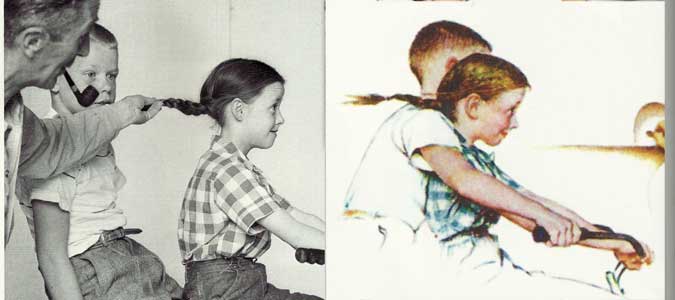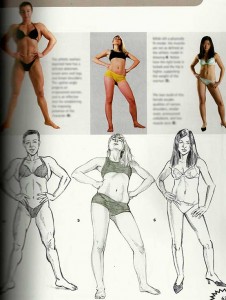This page may contain one or more affiliate links, which means that if you purchase a product through that link, I may receive compensation. The links will be identified with the text "affiliate link". Click to learn more.
Many people have the wrong idea about reference art. They use reference images to fill in the gaps for talent and skill, which is fine. However, many people think that using art reference photos gives them license for plagiarism, which is completely wrong. You cannot simply copy a photograph or trace poses without considering copyright issues.
Your mind cannot remember every detail. This is true. But you still must have creative vision to have an idea of what you want before you begin doing research for reference photos for drawing. To just have a vague idea of wanting a man jumping with a sword, for example, and then searching on the internet “man jumping with sword” may lead you to finding an awesome photograph that you want to imitate. But to copy it not only makes you unoriginal, it makes you a thief, even if you change little details. It doesn’t even make sense. Why draw or paint what has already been captured in a perfectly created photograph?
An Example of Bad Practice
Surely from browsing this site, you know that I read comic books. A major problem is what sometimes is referred to as swiping. Basically, one artist copies or traces another artist’s drawings and uses them for his own story. You would think that this would not happen that often, but it does.
Take the book The Complete Guide to Figure Drawing for Comics for example. The author reinforces this practice in the worst way possible. A very large portion of the book, drawings and all, were lifted from The Famous Artist’s Course. (Yes, the course that would be advertised in the back of old comic books) If that were not enough, most of the remaining content emphasizes to wholeheartedly copy photographs, as shown in the picture above. Basically, the entire philosophy of the book is to copy whatever you can, and the author leads by example. This raises the question: is tracing art illegal? While not always illegal, it’s certainly unethical and can lead to copyright issues.
What About Norman Rockwell?
Because Norman Rockwell took carefully planned photographs for the basis of his paintings, people think that they can pull pictures off the internet, use them as reference images, and they will be doing the same thing as the master illustrator. They often wonder, “Is it okay to use references in art?”
There is a big difference, actually. Norman Rockwell created scenes in his mind and found actors, costumes, and sets so that reference photos could solidify his vision. This is a prime example of using photos as reference for painting without violating copyright. When people pull photos off the internet, however, they are forced to work within the boundaries of that photo. It is unlikely that they will be able to find the exact angle and pose necessary for what they have pictured in their mind.
So Do I Have To Take My Own Photos?
No, although it will certainly help you if you create your own reference images during the planning phase. In my opinion, you can still use photos off the internet. However, you should have your drawing (or whatever) thought out already. When you are ready for the details, go ahead and research some reference photos to fill in the blanks. Perhaps you have made a nice figure drawing, and now the character needs clothes. So maybe you would do an internet search to find some that suit your fancy. Now that you know what they look like, you can apply the clothes to your figure. Next, you can refer to pictures of clothing folds from limbs bending, studying how the cloth bends and pulls, making your drawing even more convincing.
If you have barely any artistic ability, you can still make use of internet reference photos without copying the entire photograph. By using a combination of photos, you can find what you need as a jumping-off point. One photo might be of a figure standing at a certain angle. Another photo might be of a figure with their arms or legs in a different position, more suitable for what you had in mind. Perhaps another photo would have a facial expression that you need, or a hairstyle.
The secret is to collect multiple reference images on a piece-by-piece basis to fulfill your vision. You might find cool drawing references like a yelling drawing reference, a person holding axe drawing reference, or even a person looking behind them drawing reference. The key is to use these as inspiration, not direct copies. Of course, improvise as well so that you grow as an artist and do not become too dependent on pictures.
How to Use Photo References Without Violating Copyright
When using reference images, it’s crucial to understand copyright laws. If you trace a photo, is it still copyrighted? The answer is yes. Even if you make minor changes, tracing a copyrighted image without permission can lead to legal issues. Instead, use reference photos as a guide for understanding anatomy, lighting, or composition, but create your own unique artwork.
In Conclusion
If you use reference images incorrectly, you won’t be using the photo, but the photo will be using you. That is a good way to remember it. Why limit yourself? When you copy a photo too closely, it is like tracing it. Would people be as impressed with your artwork if they knew that you based it off of another person’s work? Would the person who took the original photograph be happy that you stole their vision for your own personal gain?
Misusing reference images can have serious consequences. In academic settings, it could result in a failing grade or even having your portfolio denied. In professional contexts, it could damage your reputation or lead to legal troubles.
Remember, it’s okay to use references in art, but do so responsibly. Use them to enhance your understanding of subject matter, not as a crutch. By learning how to use photo references without violating copyright and creating your own unique vision, you’ll grow as an artist and produce truly original work.


